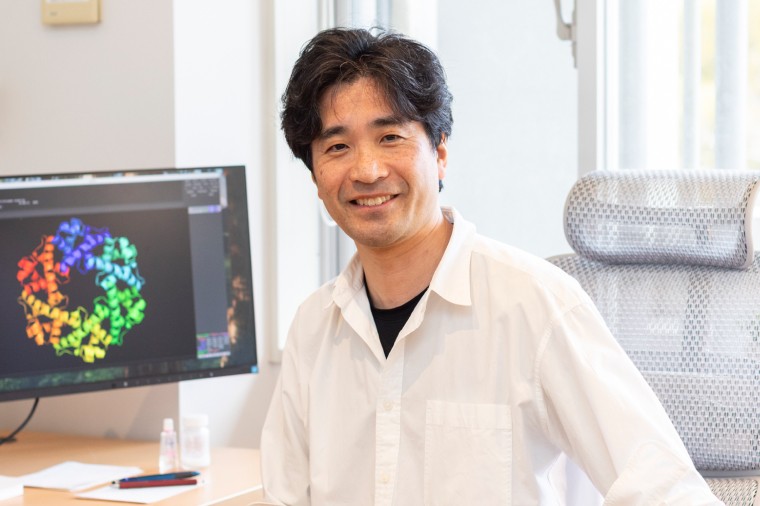Researcher
Nobuyasu Koga Director
- Laboratory:
- Laboratory for Protein Design
- Research Interests:
- Developing methods for protein design using computational and experimental approaches

Overview
Proteins are linear biopolymers composed of 20 different amino acids. Based on their amino acid sequences, proteins fold into unique three-dimensional structures, which in turn determine their functions. The number of possible amino acid sequences is enormous, with an N-residue protein having 20^N possible combinations. For instance, a protein with 100 residues can have approximately 10¹³⁰ possible sequences. Within this vast sequence space, there may be novel proteins that could be useful for medical, industrial, and cellular control applications. Our research utilizes data from naturally occurring proteins, AI, and molecular simulations to computationally design novel proteins. We then conduct biochemical experiments on these computationally designed proteins to understand the mechanisms underlying protein structure formation and functional expression. Our goal is to develop methods for designing proteins from scratch.
Q&A

What are the unique aspects or strengths of your research?
Our research combines both computational protein design and biochemical experiments. Since computationally designed proteins are purely theoretical, we need experiments to confirm whether they actually adopt the expected structure and function. In our research, we first use computers to design proteins, meaning we determine their amino acid sequences. Next, we encode these sequences into genes and introduce them into E. coli. The bacteria then produce the designed proteins, which we extract and analyze to see if they have the intended structure and function. There’s a unique sense of excitement when a protein that I designed turns out exactly as expected and performs its intended function. It’s a feeling that’s hard to compare to anything else.
Please explain how data science is involved in this research.
The function of a protein is determined by its three-dimensional structure. Since the structure of myoglobin, a protein, was first determined in 1960 (Link: https://numon.pdbj.org/mom/1?l=ja), numerous protein structures have been identified, and their structural data has been accumulated (Link to PDBj: https://pdbj.org). Unlike DNA, which has a regular double-helix structure, protein structures are highly complex, making it difficult to identify clear patterns or symmetry at a glance. In our research, we analyze and learn from experimentally determined structural data of naturally occurring proteins. By integrating these analyses with molecular simulations, we aim to design and create proteins that do not exist in nature.
Selected papers
- T. Kosugi, M. Tanabe, N. Koga, De novo design of ATPase based on a blueprint optimized for harboring the P-loop motif, Protein Science, 34(6): e70132 (2025).
https://doi.org/10.1002/pro.70132 - T. Matsuzaki, T. Saeki, F. Yamazaki, N. Koyama, T. Okubo, D. Hombe, Y. Ogura, Y. Hashino, R. Tatsumi-Koga, N. Koga, R. Iino, A. Nakamura, Development and Production of Moderate-Thermophilic PET Hydrolase for PET Bottle and Fiber Recycling, ACS Sustainable Chemistry & Engineering, 13(27), 10404-10417 (2025).
https://doi.org/10.1021/acssuschemeng.5c01602 - K. Sakuma, N. Kobayashi, T. Sugiki, T. Nagashima, T. Fujiwara, K. Suzuki, N. Kobayashi, T. Murata, T. Kosugi, R. Tatsumi-Koga, N. Koga, Design of complicated all-α protein structures, Nature Structural & Molecular Biology, 31, 275-282 (2024).
https://doi.org/10.1038/s41594-023-01147-9 - S. Minami, N. Kobayashi, T. Sugiki, T. Nagashima, T. Fujiwara, R. Tatsumi-Koga, G. Chikenji, N. Koga, Exploration of novel αβ-protein folds through de novo design, Nature Structural & Molecular Biology, 30, 1132-1140 (2023).
https://doi.org/10.1038/s41594-023-01029-0 - R. Koga, N. Koga, Consistency principle for protein design, Biophysics and Physicobiology, 16, 304-309 (2019).
https://doi.org/10.2142/biophysico.16.0_304
